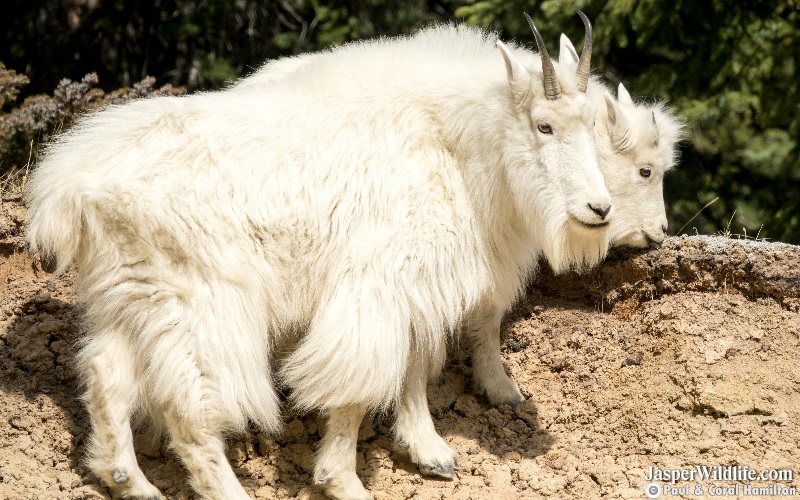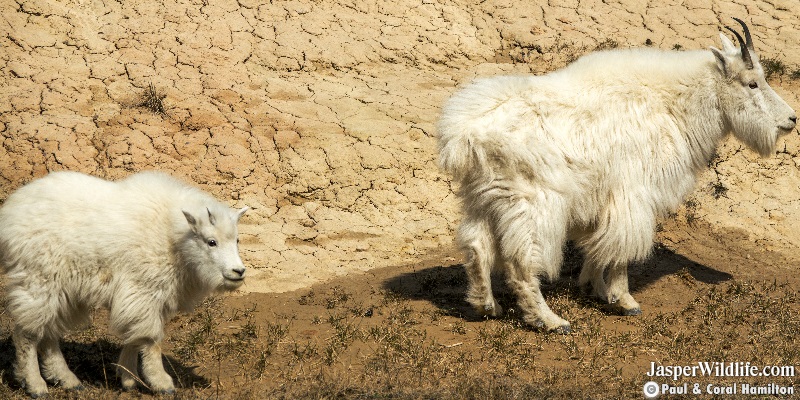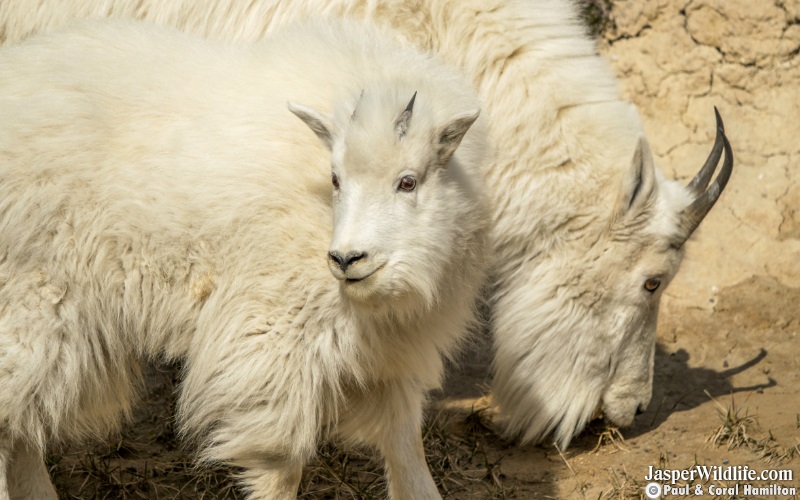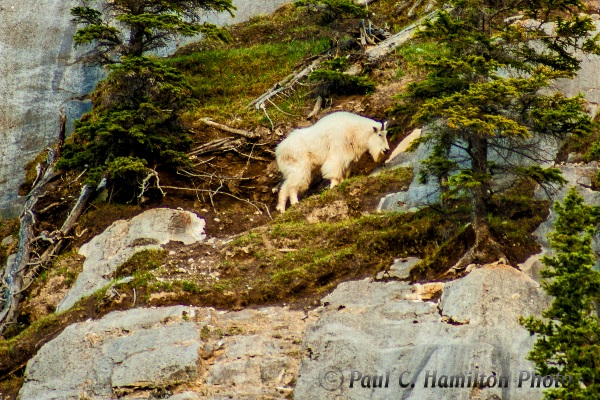(Oreamnos americanus) MOUNTAIN GOAT
How large is Jasper's Mountain Goat?
- Mass: 46 - 136 kg
Length: to 6 ft. (1.8 m) - Wildlife living area: mountains - Mountain goats prefer steep, rocky areas in alpine or sub-alpine regions. They migrate between lowland winter areas and high elevation summer ranges.
Status: no special status. - The mountain goat has only been slightly affected by humans due to its remote habitat. Recently, however, some populations have received more hunting pressure because of improved road access.
Where do Mountain Goats Live?
Mountain Goat Family Descends Looking Amazing
It has been very rare for us to have a Mountain Goat sighting during this time of year, but this Mountain Climbing Family looked incredibly healthy as they came down from altitude, possibly looking for different minerals and water. Their musculature and coats looked amazing as they could be very near their peak size during the year. Their winter coats will grow substantially yet, but it is extremely rare to see them in Winter, so this was a pretty lucky gift. Nannies always protect their young from falls and here you can witness the Kid always moving to the high side of Mum, which is an instinctual act for safety.
Rocky Mountain Goats Descending with Full Winter Coats
King of the Mountains out here; Rocky Mountain Goats have begun descending from the Alpine in Spring searching for easily accessible nutrition today. Mountain goats incredible winter coats contain distinctive beards and thick, long hair to protect them from cold temperatures and biting mountain winds at high altitudes. A sub-alpine to alpine species, Rocky Mountain Goats are very sure-footed climbers not even rivaled by Bighorns. Mountain goats are not actually goats, rather close relatives more properly known as goat-antelopes. They have hooves with two toes that can spread wide to improve balance and better grab sharp surfaces. Rough pads on the bottom of each toe provides incredible grip, such as a natural rock climbing shoe. After feeding on some valuable food, it appears that sleepiness kicks in with a stumble or two before choosing a place to bed down.
Baby Mountain Masters Emerge
Newborn Rocky Mountain Goats have grown enough for their Mothers to bring them out, which is usually about a 2 week period. These very rare animals are the Kings/Queens of the Mountains, spending much of their time at High Altitudes. We are very lucky to be able to witness some Baby Mountain Masters of slightly different ages here.
Best Mountain Climbers Cross Paths - Bighorns and Mountain Goats with Young
As you can see here, Bighorn Sheep and Rocky Mountain Goats are fine in each other's company, mountainside. If one was to be the aggressor, while smaller, it is usually the Mountain Goats. This shows some mutual curiosity between the two species that we found on a lucky day!
Biggest Mountain Master Seen So Far
The Biggest Mountain Master seen so far this Year; Rocky Mountain goats are the largest mammals found in their high-altitude habitats, which can exceed elevations of 13,000 ft (4,000 m). Here is a small group of Males still carrying their full Winter coats.
Above the Worlds Best Mountain Climber
The Rocky Mountain Goat is considered the Worlds Best Mountain Climber. This Mountain Goat looks amazing with His full winter coat as he takes a break to overlook the Athabasca River and surrounding mountain ranges. His presence makes this beautiful spot even more incredible. Mountain Goats will start to lose their winter coats very shortly as Spring turns to Summer.
Mountain Goat Babies First Appearance
Mountain Goat babies first appearance this year was a little later than usual, possibly due to predators in this area of the Canadian Rockies at lower altitudes. During these hot days, these mountain goats and their kids spent more time down by the Athabasca River. This overlook is a favorite spot in Canada's Rockies for us and the Mountain Goats certainly love it as well.
Rocky Mountain Goats descend with their Winter Coats
Mountain goats have distinctive beards and thick, long winter coats to protect them from cold temperatures and biting mountain winds as seen here. A sub-alpine to alpine species, Rocky Mountain Goats are very sure-footed climbers not even rivaled by Bighorns.
Baby Rocky Mountain Goat Appears
This is our First sighting of a Baby Mountain Goat this year. A Rocky mountain Goat Baby is called a "Kid". The Mother Mountain goat or "Nanny", gives birth usually between May 21 and June 7. Nannies give birth on isolated ledges, to a Baby weighing around 7 pounds (3.2 kg). Newborn Kids can run and leap within hours of their birth. The Mother mountain Goat will stay with her kid in isolation for three to five days before returning to the herd. A Nanny can be very aggressive when protecting her young, and is very capable of defending her newborn from predators if need be.
Rowdy Rocky Mountain Goats
When Rocky Mountain Goats herd in fairly large numbers, ranking challenges are almost constant. Compared to other ungulates, Rocky Mountain Goats have been observed as having the highest amount of aggressive interactions per hour, outside of their rutting season. Mountain Goats display their aggression by arching their back and showing their side profile to seem larger. They often rush suddenly at an opponent, or slowly push against them. You can also hear some of the vocalizations in the beginning of the video.
Rocky Mountain Goat Kids
Newborn Rocky Mountain Goat Kids enjoying the safety among the largest group of Mountain Goats we have seen here in Canada's Rockies.


This species is very sensitive to disturbance and slow to respond to management techniques. About 100,000 mountain goats are estimated to live in North America.
Range: Native range is from southeast Alaska to Washington, western Montana, and central Idaho. Introduced in sections of South Dakota, Colorado, and Washington.
Bear Tries His Luck with Mountain Goats
A Bear tries his luck in catching a Mountain Goat when they were down in altitude today. While the Bear almost cut one mountain goat off ascending back up, you can clearly see that even the incredible agility of the newborn Mountain Goats keep them out of most predator's reach.
Mountain Goats Being Aggressive
Canadian Rockies Mountain Goats, compared to other ungulates, are highly aggressive to one another. Female Mountain Goats are dominant, except during the rut in the fall when males compete with each other. Females, being the more aggressive of the two sexes, can have many aggressive interactions per hour.
In studied populations in Alberta, Canadian female mountain goats had an average of 3.4 aggressive interactions per hour when in a group, which is the highest amount for any wild female ungulate measured. Mountain Goats display their aggression by arching their back and showing their side profile to seem larger. They can often rush suddenly at an opponent, or slowly push against them while walking by. Mountain Goat Fights do not usually escalate to extreme levels.
While Bighorn Sheep possess the capability of plowing just about anything off of a Mountain Edge, when occupying the same area as Mountain Goats; Bighorn Sheep usually give way to the more aggressive Mountain Goat.
Mountain Goats in Canada's Rockies still Carrying their Amazing Winter Coats
Mountain Goat Climbing in the Rocky Mountains
Details on the Mountain Goat in Jasper
Mountain goats are stout bodied with a thick coat made up of white hairs with some brown intermixed dorsally.
The pure black horns are around 200-300mm long, rather thin, and present on both sexes. Mountain goats have relatively large, oval hooves with an almost rubber-like sole that aids them in climbing steep rock.
They have black glands between their horns that are used to scent mark.
Mountain goat tracks are 2.5 - 3.5 in. (6 - 9 cm.) long and are splayed somewhat in front. This may give the appearance of a 'square' track.


Mountain Goat Tracks
